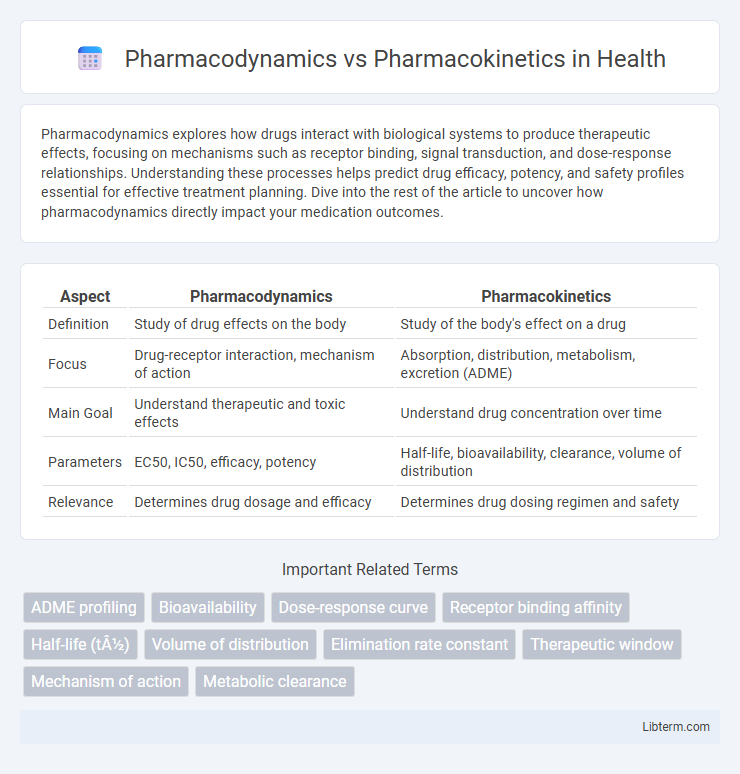Pharmacodynamics explores how drugs interact with biological systems to produce therapeutic effects, focusing on mechanisms such as receptor binding, signal transduction, and dose-response relationships. Understanding these processes helps predict drug efficacy, potency, and safety profiles essential for effective treatment planning. Dive into the rest of the article to uncover how pharmacodynamics directly impact your medication outcomes.
Table of Comparison
| Aspect | Pharmacodynamics | Pharmacokinetics |
|---|---|---|
| Definition | Study of drug effects on the body | Study of the body's effect on a drug |
| Focus | Drug-receptor interaction, mechanism of action | Absorption, distribution, metabolism, excretion (ADME) |
| Main Goal | Understand therapeutic and toxic effects | Understand drug concentration over time |
| Parameters | EC50, IC50, efficacy, potency | Half-life, bioavailability, clearance, volume of distribution |
| Relevance | Determines drug dosage and efficacy | Determines drug dosing regimen and safety |
Introduction to Pharmacodynamics and Pharmacokinetics
Pharmacodynamics explores how drugs interact with biological targets to produce therapeutic effects by studying receptor binding, dose-response relationships, and drug efficacy. Pharmacokinetics examines the absorption, distribution, metabolism, and excretion (ADME) of drugs, determining the concentration of a drug at its site of action over time. Understanding both pharmacodynamics and pharmacokinetics is crucial for optimizing drug dosing, efficacy, and safety in clinical therapeutics.
Defining Pharmacokinetics: The Body’s Role
Pharmacokinetics examines how the body absorbs, distributes, metabolizes, and eliminates drugs, playing a vital role in determining the onset, intensity, and duration of a drug's effect. It involves key processes such as bioavailability, volume of distribution, clearance, and half-life that influence drug concentration in the bloodstream over time. Understanding pharmacokinetics enables precise dosing regimens, minimizes toxicity risks, and optimizes therapeutic outcomes.
Exploring Pharmacodynamics: Drug’s Action on the Body
Pharmacodynamics examines how drugs interact with cellular receptors and enzymes to produce physiological effects, focusing on the mechanisms of drug action and the relationship between drug concentration and effect. It analyzes dose-response curves, receptor affinity, and efficacy to understand therapeutic outcomes and potential side effects. Key parameters include potency, maximal effect (Emax), and the drug's ability to activate or inhibit biological pathways.
Key Differences Between Pharmacodynamics and Pharmacokinetics
Pharmacodynamics describes the biochemical and physiological effects of drugs and their mechanisms of action at target sites, focusing on drug-receptor interactions and the resultant therapeutic or toxic effects. Pharmacokinetics involves the absorption, distribution, metabolism, and excretion (ADME) of drugs, determining the concentration of a drug at its site of action over time. Key differences include pharmacodynamics' emphasis on drug effects and pharmacokinetics' role in drug movement and concentration within the body, which together guide optimal dosing and efficacy.
Major Components of Pharmacokinetics: ADME
Pharmacokinetics involves the study of drug absorption, distribution, metabolism, and excretion (ADME), which are critical for determining a drug's concentration at target sites and its therapeutic effectiveness. Absorption defines how a drug enters the bloodstream, distribution describes its dispersion through body tissues, metabolism involves chemical modification primarily in the liver, and excretion constitutes the elimination of the drug via renal or biliary pathways. Understanding these pharmacokinetic components enables optimization of drug dosing regimens, reduces toxicity, and improves overall patient outcomes compared to pharmacodynamics, which focuses on drug-receptor interactions and biochemical effects.
Mechanisms of Pharmacodynamic Responses
Pharmacodynamics explores the biochemical and physiological effects of drugs on target receptors, enzymes, or ion channels, dictating the magnitude and duration of therapeutic responses. It involves the drug-receptor binding affinity, intrinsic activity, and dose-response relationships that determine efficacy and potency. Understanding these mechanisms is crucial for optimizing drug dosage, minimizing adverse effects, and tailoring personalized treatments.
Factors Affecting Pharmacokinetics
Factors affecting pharmacokinetics include absorption, distribution, metabolism, and excretion processes that determine drug concentration in the body over time. Age, genetic makeup, liver and kidney function, and the presence of other drugs or food can significantly modify these pharmacokinetic parameters. Understanding these influences is crucial for optimizing dosage, minimizing toxicity, and enhancing therapeutic efficacy.
Factors Influencing Pharmacodynamic Effects
Pharmacodynamic effects are influenced by receptor sensitivity, drug concentration at the target site, and patient-specific factors such as genetics and age. The interaction between the drug and its receptor, including affinity and intrinsic activity, determines the magnitude of the therapeutic response. Environmental factors and concurrent medications can also modify receptor function, altering drug efficacy and safety profiles.
Clinical Relevance: Applications in Drug Development
Pharmacodynamics (PD) examines drug effects on the body, focusing on receptor interactions, dose-response relationships, and therapeutic outcomes, crucial for identifying effective drug targets and optimizing dosing regimens in clinical trials. Pharmacokinetics (PK) studies drug absorption, distribution, metabolism, and excretion (ADME), essential for determining bioavailability, half-life, and clearance to ensure optimal drug concentration profiles and minimize toxicity. Integrating PK/PD modeling enhances drug development by predicting clinical efficacy and safety, streamlining dose selection, and supporting regulatory approval processes.
Conclusion: Integrating Pharmacokinetics and Pharmacodynamics for Optimal Therapy
Integrating pharmacokinetics and pharmacodynamics is crucial for optimizing drug therapy by ensuring proper dosing, maximizing therapeutic effects, and minimizing toxicity. Pharmacokinetics determines drug absorption, distribution, metabolism, and excretion, while pharmacodynamics focuses on drug-receptor interactions and biological effects. Combining these disciplines allows personalized medicine approaches that improve efficacy and safety tailored to individual patient variations.
Pharmacodynamics Infographic

 libterm.com
libterm.com